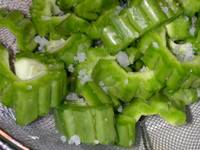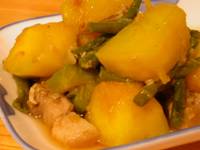On our stove there were always mysterious little pots of unfamiliar vegetables with names like "bulanglang, dinengdeng, pinakbet." My mom favored the helpers who could interpret these dishes for her. She'd instruct them on how to make what to me seemed like foreign food. I never touched the stuff for they looked too strange and tasted too strong for a child's palate(with okra, alugbati, saluyot leaves) then but now I crave them. Strangely enough.
So here I am, trying to duplicate those dishes that my mother set aside to satisfy her childhood memories. She had these separately from the main entrees for her husband and kids. I never learned how to cook them until I came here to be with my husband, and observed her closely whenever she visited and I asked her to make them for us.(Luckily husband is "acculturated.")
Ingredients:
a half a slab of pork belly (or other fatty cuts of pork),cubed
3 cloves of garlic,crushed
2 shallots, or 1 medium onion, or a combination, diced
1 small tomato, chopped
1/2 bundle of "sitaw" (yard long beans), 3-in. lengths
2 Asian egg plants,halved lengthwise, sliced 3-in. lengths
1 bitter melon "ampalaya", halved lengthwise, cored, sliced 1/4 inch pieces
1/4 of squash (this time I used "kabocha" as shown in Obachan's kitchen), cut into 2-in. cubes
2 tbsp. of "Wang" brand tiny shrimp in brine, or 1/4 c. fresh peeled shrimp, chopped
(plus bagoong, shrimp paste, to
taste)
chicken broth or water, soy or fish sauce, salt and pepper.
Put ampalaya in colander and sprinkle about 1 tbsp. sea salt or kosher salt. Let sit for 1/2 hour (this step eliminates bitterness and excess water, allowing ampalaya to stay crunchy). Rinse and drain thoroughly.

Put pork belly pieces in wok with enough water to cover. Sprinkle 1 tsp. salt, bring to boil, then simmer until pork is tender (adding more liquid if needed).
When liquid is gone and pork is soft, add a little vegetable oil and brown pork, set aside to edge of wok and add garlic, shallots/onions, tomatoes and stir fry until onions are translucent. Add shrimp. Stir fry and mix well.

I used this as a substitute, curious about how it tasted (too lazy to go out and get fresh shrimp)
Add egg plant and 1/4 cup of broth or water. Cover and let cook for about 3 minutes, checking to prevent eggplant going soggy. Add sitaw and ampalaya. Stir fry then cover about 3 minutes. Check with fork to test doneness. When preceding vegetables start to get just soft, add squash cubes and then cover (keep adding broth or water and salt if it gets too dry). Splash some soy sauce and adjust seasonings. Test vegetables for doneness, taking care not to overcook.

The "Wang" shrimp turned out really well, subtle and not too salty.
Sometimes Ma put a dried fish (like danggit) or even a left over fried fish...
Husband liked this so much he ate two platefuls with rice. He also asked me to remember the ingredients for this, for a repeat performance.
**Thanks to Manang whose mention of ampalaya sparked a Proustian moment.
